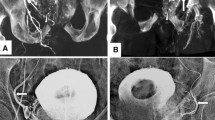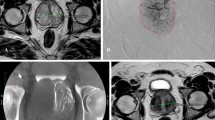Abstract
Purpose
To investigate the clinical impact of performing prostate artery embolization (PAE) on patients with adenomatous-dominant benign prostatic hyperplasia (AdBPH).
Materials and Methods
Twelve patients from the ongoing proSTatic aRtery EmbolizAtion for the treatMent of benign prostatic hyperplasia (STREAM) trial were identified as having AdBPH; defined as two or more adenomas within the central gland of ≥1 cm diameter on multi-parametric MRI (MP-MRI). These patients were age-matched with patients from the STREAM cohort, without AdBPH. Patients were followed up with repeat MP-MRI at 3 months and 1 year. International prostate symptom score (IPSS), international index for erectile function (IIEF), and quality of life assessment from the IPSS and EQ-5D-5S questionnaires were recorded pre-PAE and at 6 weeks, 3 months, and 1 year.
Results
The mean age of patients was 68 (61–76). All patients had PAE as a day-case procedure. The technical success in the cohort was 23/24 (96%). There was a significant reduction in prostate volume following embolization with a median reduction of 34% (30–55) in the AdBPH group, compared to a mean volume reduction of 22% (9–44) in the non-AdBPH group (p = 0.04). There was a significant reduction in IPSS in the AdBPH group following PAE when compared with the control group [AdBPH median IPSS 8 (3–15) vs. non-AdBPH median IPSS 13 (8–18), p = 0.01]. IPSS QOL scores significantly improved in the AdBPH group (p = 0.007). There was no deterioration in sexual function in either group post-PAE.
Conclusions
This is the first time that AdBPH has been identified as being a predictor of clinical success following PAE.




Similar content being viewed by others
References
Guess HA, Arrighi HM, Metter EJ, Fozard JL. Cumulative prevalence of prostatism matches the autopsy prevalence of benign prostatic hyperplasia. Prostate. 1990;17(3):241–6.
Rosen RC, Giuliano F, Carson CC. Sexual dysfunction and lower urinary tract symptoms (LUTS) associated with benign prostatic hyperplasia (BPH). Eur Urol. 2005;47(6):824–37.
Glina S, Glina FPA. Pathogenic mechanisms linking benign prostatic hyperplasia, lower urinary tract symptoms and erectile dysfunction. Ther Adv Urol. 2013;5(4):211–8.
McNeal JE. Origin and evolution of benign prostatic enlargement. Invest Urol. 1978;15(4):340–5.
Shapiro E, Hartanto V, Lepor H. The response to alpha blockade in benign prostatic hyperplasia is related to the percent area density of prostate smooth muscle. Prostate. 1992;21(4):297–307.
Shapiro E, Becich MJ, Hartanto V, Lepor H. The relative proportion of stromal and epithelial hyperplasia is related to the development of symptomatic benign prostate hyperplasia. J Urol. 1992;147(5):1293–7.
Sun F, Crisóstomo V, Báez-Díaz C, Sánchez FM. Prostatic artery embolization (PAE) for symptomatic benign prostatic hyperplasia (BPH): part 1, pathological background and clinical implications. Cardiovasc Intervent Radiol. 2016;39(1):1–7.
MRI of the Female and Male Pelvis Riccardo Manfredi Springer [Internet]. [cited 2017 Jan 21]. http://www.springer.com/gp/book/9783319096582.
Wasson JH, Reda DJ, Bruskewitz RC, Elinson J, Keller AM, Henderson WG. A comparison of transurethral surgery with watchful waiting for moderate symptoms of benign prostatic hyperplasia. The Veterans Affairs Cooperative Study Group on Transurethral Resection of the Prostate. N Engl J Med. 1995;332(2):75–9.
Pisco JM, Rio Tinto H, Campos Pinheiro L, Bilhim T, Duarte M, Fernandes L, et al. Embolisation of prostatic arteries as treatment of moderate to severe lower urinary symptoms (LUTS) secondary to benign hyperplasia: results of short- and mid-term follow-up. Eur Radiol. 2013;23(9):2561–72.
Carnevale FC, da Motta-Leal-Filho JM, Antunes AA, Baroni RH, Freire GC, Cerri LMO, et al. Midterm follow-up after prostate embolization in two patients with benign prostatic hyperplasia. Cardiovasc Intervent Radiol. 2011;34(6):1330–3.
DeMeritt JS, Elmasri FF, Esposito MP, Rosenberg GS. Relief of benign prostatic hyperplasia-related bladder outlet obstruction after transarterial polyvinyl alcohol prostate embolization. J Vasc Interv Radiol JVIR. 2000;11(6):767–70.
Carnevale FC, Iscaife A, Yoshinaga EM, Moreira AM, Antunes AA, Srougi M. Transurethral resection of the prostate (TURP) versus original and PErFecTED prostate artery embolization (PAE) due to benign prostatic hyperplasia (BPH): preliminary results of a single center, prospective, urodynamic-controlled analysis. Cardiovasc Intervent Radiol. 2016;39(1):44–52.
Textbook of Benign Prostatic Hyperplasia, Second Edition [Internet]. CRC Press. 2004 [cited 2017 Jan 21]. https://www.crcpress.com/Textbook-of-Benign-Prostatic-Hyperplasia-Second-Edition/Kirby-McConnell-Fitzpatrick-Roehrborn-Boyle/p/book/9781901865554.
Frenk NE, Baroni RH, Carnevale FC, Gonçalves OMG, Antunes AA, Srougi M, et al. MRI findings after prostatic artery embolization for treatment of benign hyperplasia. AJR Am J Roentgenol. 2014;203(4):813–21.
Kisilevzky N, Faintuch S. MRI assessment of prostatic ischaemia: best predictor of clinical success after prostatic artery embolisation for benign prostatic hyperplasia. Clin Radiol. 2016;71(9):876–82.
Pyo J-S, Cho WJ. Systematic review and meta-analysis of prostatic artery embolisation for lower urinary tract symptoms related to benign prostatic hyperplasia. Clin Radiol. 2017;72(1):16–22.
Sun F, Sánchez FM, Crisóstomo V, Lima JR, Luis L, García-Martínez V, et al. Benign prostatic hyperplasia: transcatheter arterial embolization as potential treatment–preliminary study in pigs. Radiology. 2008;246(3):783–9.
Bagla S, Smirniotopoulos JB, Orlando JC, van Breda A, Vadlamudi V. Comparative analysis of prostate volume as a predictor of outcome in prostate artery embolization. J Vasc Interv Radiol JVIR. 2015;26(12):1832–8.
De Assis AM, Moreira AM, de Paula Rodrigues VC, Yoshinaga EM, Antunes AA, Harward SH, et al. Prostatic artery embolization for treatment of benign prostatic hyperplasia in patients with prostates >90 g: a prospective single-center study. J Vasc Interv Radiol JVIR. 2015;26(1):87–93.
Kurbatov D, Russo GI, Lepetukhin A, Dubsky S, Sitkin I, Morgia G, et al. Prostatic artery embolization for prostate volume greater than 80 cm3: results from a single-center prospective study. Urology. 2014;84(2):400–4.
Wang MQ, Guo LP, Zhang GD, Yuan K, Li K, Duan F, et al. Prostatic arterial embolization for the treatment of lower urinary tract symptoms due to large (>80 ml) benign prostatic hyperplasia: results of midterm follow-up from Chinese population. BMC Urol. 2015;16(15):33.
Pisco J, Bilhim T, Pinheiro LC, Fernandes L, Pereira J, Costa NV, et al. Prostate embolization as an alternative to open surgery in patients with large prostate and moderate to severe lower urinary tract symptoms. J Vasc Interv Radiol JVIR. 2016;27(5):700–8.
Isaacson AJ, Raynor MC, Yu H, Burke CT. Prostatic artery embolization using embosphere microspheres for prostates measuring 80–150 cm3: early results from a us trial. J Vasc Interv Radiol JVIR. 2016;27(5):709–14.
Pisco J, Bilhim T, Pinheiro LC, Fernandes L, Pereira J, Costa NV, et al. Prostate embolization as an alternative to open surgery in patients with large prostate and moderate to severe lower urinary tract symptoms. J Vasc Interv Radiol JVIR. 2016;27(5):700–8.
Bilhim T, Pisco J, Rio Tinto H, Fernandes L, Campos Pinheiro L, Duarte M, et al. Unilateral versus bilateral prostatic arterial embolization for lower urinary tract symptoms in patients with prostate enlargement. Cardiovasc Intervent Radiol. 2013;36(2):403–11.
Zhang G, Wang M, Duan F, Yuan K, Li K, Yan J, et al. Radiological findings of prostatic arterial anatomy for prostatic arterial embolization: preliminary study in 55 chinese patients with benign prostatic hyperplasia. PLoS One. 2015;10(7):e0132678.
Bilhim T, Pisco JM, Rio Tinto H, Fernandes L, Pinheiro LC, Furtado A, et al. Prostatic arterial supply: anatomic and imaging findings relevant for selective arterial embolization. J Vasc Interv Radiol JVIR. 2012;23(11):1403–15.
Acknowledgements
The authors wish to acknowledge the Royal College of Radiologists, UK, and Oxfordshire Health Services Research Committee (OHSRC) (Grant No. 1170) for funding the study.
Author information
Authors and Affiliations
Corresponding authors
Ethics declarations
Conflict of interest
On behalf of all authors, the corresponding author states that there is no conflict of interest.
Rights and permissions
About this article
Cite this article
Little, M.W., Boardman, P., Macdonald, A.C. et al. Adenomatous-Dominant Benign Prostatic Hyperplasia (AdBPH) as a Predictor for Clinical Success Following Prostate Artery Embolization: An Age-Matched Case–Control Study. Cardiovasc Intervent Radiol 40, 682–689 (2017). https://doi.org/10.1007/s00270-017-1602-8
Received:
Accepted:
Published:
Issue Date:
DOI: https://doi.org/10.1007/s00270-017-1602-8




